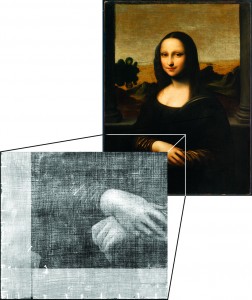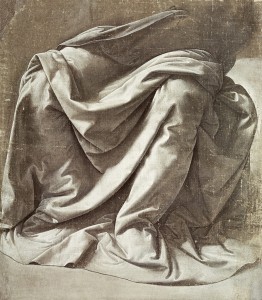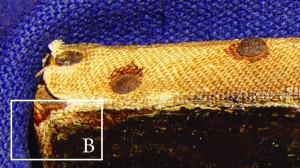The main characteristics of the linen canvas used for the earlier version portrait were straightforward: plain tabby weaves with an average thread count of 18 threads per cm warp, and 16 threads per cm weft, crossing each other of course, and with some variations in thickness. The result is a warp that is slightly tighter than the weft. That Leonardo would choose available canvas instead of a wood panel upon which to paint a portrait is really not that surprising. One of the major criticisms put forward against the Leonardo attribution of the ‘Earlier Mona Lisa’ to Leonardo relates to its canvas support. However, when the matter is examined in detail, it is easily put to rest.

The support, which has a tight warp and a loose weft, is made of linen cloth. The coarse and irregular weave are indicative of a hand-woven canvas.

Drapery study for a Seated Figure. Oil on canvas, c. 1475-1480, Leonardo da Vinci.
Leonardo had Worked on Canvas
Leonardo executed a number of works on canvas while working under Verrocchio in the 1470s. It is no coincidence that the drapery studies that Leonardo painted on canvas roughly 30 years earlier, and that are now in the Louvre, display almost identical characteristics to those of the earlier version. As with the ‘Earlier Mona Lisa’, these canvasses of course were also naturally hand-woven.
Historical Context
The turn of the 16th Century marked a significant period of transition in the use of artists’ materials. Knowledge about the use of new media from advanced Flemish and Venetian masters was becoming more widespread. Oil and artificial pigments were starting to become popular: in fact Leonardo was using oil as a binder and medium as far back as his time as a student of Verrocchio. Up to the 16th Century, wood was the most popular support for painting, and prior to 1470 almost nothing of importance in Western art was painted on canvas. Leonardo’s ‘Lady with the Ermine’ and ‘La Belle Ferronniere’ were painted on walnut panels. The Louvre ‘Mona Lisa’ on the other hand, was painted on poplar, a wood more frequently found in Lombardy than Tuscany.
Canvas was, by 1500, already in use by painters in Italy. It is known that c.1499-1500 Leonardo visited Venice via Mantua, on his return to Florence after his sojourn in Milan. In Mantua, he would likely have met with Andrea Mantegna, the Court Painter for Isabella d’Este at that time. Mantegna was a great exponent of painting on canvas, and might well have influenced Leonardo. Vittore Carpaccio, from Venice, is also of particular relevance, as he was of the same age and lived during the same times as Leonardo as did Giorgione. It is considered that Leonardo collected some new ideas from Venetian masters, certainly about the use of glass in pigments, in addition to the use of canvas as a support. All of this occurred just before he set to task on Mona Lisa.
It can clearly be seen that from and subsequent to Leonardo’s working life, the use of canvas as a support was coming into greater use: not just with Dutch and Venetian masters, but also with Germans, Florentines and other Italians. There is also well documented evidence of masterworks Leonardo’s contemporaries some of whom, as stated above, he would have been in direct contact, including:
• Sandro Boticelli (1446-1510)
‘The Birth of Venus’, c.1482-1485 (Florence)
• Giorgione (1477-1510)
‘The Tempest’ c.1508 (Venice)
• Andrea Mantegna (c.1431-1506)
‘The Holy Family with St. Elizabeth and the Young St. John’, c.1498-1499 (Dresden)
‘The Mourning over the Dead Christ’, c.1501 (Milan)
• Raffaello Santi (Raphael) (1483-1520)
‘Lady with a Unicorn’, c.1504-1505 (canvas, transferred to panel)(Rome)
‘The Sistine Madonna’, c.1516 (Dresden)
‘Portrait of Count Castiglione’, 1515 (Paris)
• Tiziano Vecellio (Titian) (1488-1576)
‘La Bella’, 1536-1538 (Florence)
‘Ecce Homo’, 1543 (Vienna)
‘Portrait of the Artist’, c.1565 (Madrid)
• Vittore Carpaccio (c.1455-1525)
‘St. Ursula’s Arrival in Cologne’, 1490-1495 (Venice)
‘The Blood of the Redeemer’, 1496 (Udine)
• Tintoretto (Real name: Jacopo Comin [a.k.a. Jacopo Robusti]) (1518 -1594)
‘The Erection of the Cross of the Repentant Thief ’, 1565 (Venice)
Leonardo the Experimenter
One cannot forget that Leonardo was not only a great inventor and innovator, but he was continually experimenting with new ideas and technology. It is timely to note that a small work of art executed on vellum in the early 1490s has recently been authenticated as a Leonardo. This is particularly noteworthy as Leonardo had not been known until now to have produced any finished work on that material, before or since. In his book La Bella Principessa, Martin Kemp writes “It shows him utilizing a medium that has not previously been observed in his ‘oeuvre’, but one that relates closely to his interest in the French artist Jean Perreal. It testifies to his spectacular exploration and development of novel media, tackling each commission as a fresh technical and aesthetic challenge.”
There is every reason to believe, given Leonardo’s inquisitive nature and the historical context that he would certainly have experimented with canvas at the turn of the 16th Century. The drapery studies are also particularly relevant, as they emphasise Leonardo’s classical concerns for accuracy in rendering the folds of clothing, and how they can reveal the human anatomy beneath.
Leonardo wrote about how to paint on Canvas
Though the foregoing suggests that it would be no surprise that Leonardo used a canvas support for some of his works, one fact pretty well confirms beyond reasonable doubt that he did. In his Treatise On Painting Leonardo describes in detail not only how to prepare canvas for painting, but also how to paint on it. Modo Di Colorir In Tela (How to paint on canvas) – CAP CCCLIII.
Leonardo sets down the basic instructions: “Stretch the canvas onto a chassis, then apply a light coat of fluid glue and let it dry. Then draw your painting with tone using silk brushes adding, in your style the “sfumato” technique to place the shadows while the paint is still fresh. The complexion is made-up of white of ceruse lacquer, and Flanders yellow; the shadow will be made from black, burnt umber and a little lacquer, or if you prefer, a hard pencil. After completing the “sfumato” let the work dry; then do dry retouches with a solution of diluted lacquer in gum arabic that has been left a long time. The longer the mixture is left the better the result, as it remains matt. If you want your shadows darker, take the same gummed lacquer, adding ink. You can use this mixture to shade numerous other colours including azurite, lacquer, etc., because it is transparent. I have stated for the shadows, now for the highlights you can make tints from using a simple gum arabic lacquer over the top of undiluted lacquer and over this is applied a diluted veil of dry cinnabar.”
Now this description is key for two reasons. First, it demonstrates unquestionably that Leonardo did paint on canvas. All of this knowledge was gathered through real life experiences and experiments and it would be simply impossible to believe he would describe the details of a process he never executed himself. Second, the level of detail in which he describes the process is strongly suggestive that his use of canvas extended beyond simple studies. This implies that there would be major works by Leonardo, such as the ‘Earlier Mona Lisa’, that were executed on the material. It is believed that about half of Leonardo’s paintings may still be missing or still to be correctly attributed. Given the above, it is quite likely that a number of these works were executed on canvas support.
Another extremely important point relating to the ‘Earlier Mona Lisa’ is that its very existence on canvas instead of a wood panel belies any suggestion and is just one more piece of evidence against the idea that it could ever have been a ‘copy’ of the Louvre version, or vice versa. Clearly, and as is discussed in detail in the section about comparisons, Leonardo would have intended to make two different versions. Furthermore, if Leonardo was considering an opportunity for his earlier version to be in any way experimental, especially in content or composition, then it is most credible that he might have used canvas as a familiar and convenient material.

See above image of canvas detail, taken from this edge of the painting.